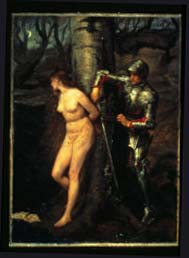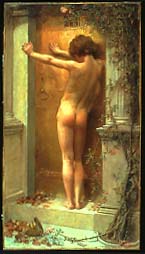Exhibition Reviews
| Home | | Museum Guide | | International | | Theater |
There's More to the Victorians Than Meets the Eye
 |
| AIDING A MAIDEN IN DISTRESS -- "The Knight Errant" by John Everett Millais |
"Exposed: The Victorian Nude"
The Brooklyn Museum of Art, 200 Eastern Parkway, Brooklyn.
718-638-5000
Museum Admission by Contribution: $6, students and seniors $3, children under
12 free.
Sept. 6, 2002 - Jan. 5, 2003
By Paulanne Simmons
Even in a country noted for its stiff upper lip and disapproving frown the Victorian era stands out for its overwhelming prudery.
Did British artists adhere to the strict and stifling moral code of their times? The Tate Britain answers this question with a resounding "no" and has organized "Exposed: The Victorian Nude" to prove the point.
Heralding the exhibition as the first "to survey the full range of representation of the male and female nude during the reign of Queen Victoria," the Brooklyn Museum of Art is hosting the exhibition's only stop in North America from Sept. 6, 2002 through Jan. 5, 2003.
This gives New Yorkers four months to view the extensive collection of some 150 works ranging from painting and sculpture to popular illustration, photography and moving pictures.
The exhibition is loosely organized chronologically but is also divided into six major themes. This presents some problems in achieving the goal "to trace the history of the Victorian nude and its reception," as many works do not fit neatly into their chronological and thematic niche.
But if you're not too concerned with exact timelines and precise categories, you can just enjoy the show and treat all the verbiage as interesting but not essential commentary.
The six categories are The English Nude, which puts the nude in a distinctly English literary and historical context; The Classical Nude, which shows the new emphasis on antique sources; The Private Nude, which explores imagery largely produced for private contemplation; The Artist's Studio, which treats the theme of artist and model; The Nude in High Art, which concentrates on larger scale and more socially conscious work; and The Modern Nude, which traces the rise of a more naturalistic treatment of the body.
The exhibition contains an interesting mix of the saccharine, the salacious and the sublime. Pederasty, pedophilia and prostitution abound.
Nude pre-pubescent boys cavort in and around a rowboat in Henry Scott Tuke's August Blue (1893). William Goscombe John's bronze A Boy at Play (1895) depicts a lithe, nude boy with a strong chest and straight limbs perfectly balanced on one foot. Any number of paintings show not very virginal women languishing on beds, sometimes with rumpled sheets.
There's also more than a touch of sado-masochism.
 |
| DESIRABLE, OR JUST DEAD? -- "Saint Eulalia" by John William Waterhouse |
In John Everett Millais The Knight Errant (1870), a knight frees a nude woman tied to a tree. The martyred Saint Eulalia lies semi-nude on the snow after her execution in John William Waterhouse's Saint Eulalia (1885).
Some of the work is openly erotic.
In Dante Gabriel Rossetti's Venus Verticordia (1864-1868), the voluptuous goddess holds one of Cupid's deadly arrows in one hand and that old object of temptation, the apple, in the other.Other works use high-minded themes to justify an erotic subtext.
 |
| ENDURING LOVE OR PEDOPHELIA? -- "Love Locked Out" by Anna Lea Merritt |
Anna Lea Merritt has titled her full-length back view of a nude boy pushing on a closed door Love Locked Out (1889) as a tribute to her deceased husband.
Annie Swynnerton's New Risen Hope (1904) portrays a nude rosy-cheeked curly-haired little girl as a symbol of female emancipation.
Charles William Mitchell's Hypatia (1889) depicts the moment when the pagan philosopher Hypatia, stripped and dragged to the church altar by a mob of fanatical monks, clasps her long golden locks to her naked body and appeals for justice and mercy.
There is no doubt that much of this exhibition has a peep-show quality - especially in work such as Audrey Beardsley's drawing of a masturbating voyeur for "The Impatient Adulterer" (1896) or Edward Linley Sambourne's untitled photograph of Maude Eaton in Pulcinella costume, seated in an armchair with her legs spread and her skirts up (1891).
But there's also a good deal that's arresting for its sheer beauty or originality - Frederic Leighton's The Sluggard (1886), a bronze statue of a sensuous and virile athlete languidly flexing his muscles; Simeon Solomon's strangely surrealist painting The Sleeping Endymion (1887); Lawrence Alma-Tadema's intensely erotic painting Tepidarium (1882).
If the nude, alternately interpreted as a sign of aesthetic advancement or moral decay, reflects a society's attitudes on sexuality, public health, social welfare, racial attitudes, suffragist issues, religion and censorship, as this exhibition proposes, then Exposed: The Victorian Nude is definitely … well … revealing.
[PS]